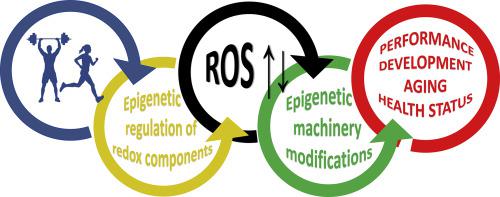Redox Biology ( IF 11.4 ) Pub Date : 2020-02-26 , DOI: 10.1016/j.redox.2020.101477 Ivan Dimauro 1 , Maria Paola Paronetto 2 , Daniela Caporossi 1

|
Physical exercise represents one of the strongest physiological stimuli capable to induce functional and structural modifications in all biological systems. Indeed, beside the traditional genetic mechanisms, physical exercise can modulate gene expression through epigenetic modifications, namely DNA methylation, post-translational histone modification and non-coding RNA transcripts.
Initially considered as merely damaging molecules, it is now well recognized that both reactive oxygen (ROS) and nitrogen species (RNS) produced under voluntary exercise play an important role as regulatory mediators in signaling processes. While robust scientific evidences highlight the role of exercise-associated redox modifications in modulating gene expression through the genetic machinery, the understanding of their specific impact on epigenomic profile is still at an early stage. This review will provide an overview of the role of ROS and RNS in modulating the epigenetic landscape in the context of exercise-related adaptations.
中文翻译:

运动,氧化还原稳态和表观遗传景观。
体育锻炼是最强的生理刺激之一,能够在所有生物系统中诱导功能和结构的改变。实际上,除了传统的遗传机制外,体育锻炼还可以通过表观遗传修饰(即DNA甲基化,翻译后组蛋白修饰和非编码RNA转录本)调节基因表达。
最初仅被认为是破坏性分子,现在人们已经认识到,在自愿锻炼下产生的活性氧(ROS)和氮素(RNS)在信号传递过程中起调节介质的作用。虽然有力的科学证据强调了运动相关的氧化还原修饰在通过遗传机制调节基因表达中的作用,但对它们对表观基因组谱的特殊影响的理解仍处于早期阶段。这篇综述将概述ROS和RNS在与运动有关的适应情况下在调节表观遗传环境中的作用。



























 京公网安备 11010802027423号
京公网安备 11010802027423号